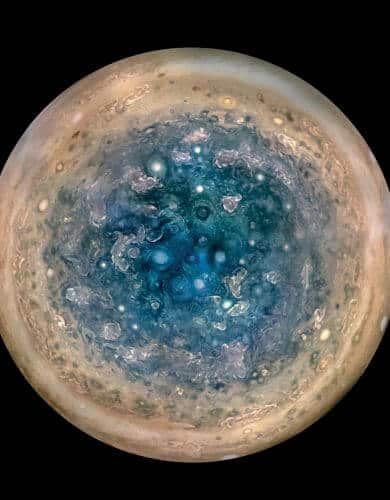Scientists from the Weizmann Institute lead one of the central experiments of the Juno space mission, which aims to find out how deep the strong jet streams that characterize Jupiter

More than 400 years after Galileo Galilei pointed his telescope at the planet Jupiter, the veil of clouds and fog covering the largest planet in the solar system is beginning to dissipate. Although no fewer than six spacecraft have been sent to Jupiter since 1973, the Juno probe, which was launched in 2011 and has been orbiting the star since July 2016, is the first spacecraft equipped with instruments that will allow it to reveal the secrets of Jupiter's internal structure beneath the cloud cover.
In the limited group of about 40 scientists from around the world who share in the research mission of the American space agency NASA, there is also a representative from the Weizmann Institute: Dr. Yohai Caspi from the Department of Earth and Planetary Sciences and his partner in the research group, staff scientist Dr. Eli Galanti. The two are leading one of the main experiments inThe Juno space mission, which aims to find out how deep the strong jet streams that characterize Jupiter are and to map the star's gravitational field.
Recently were published in the scientific journal Science Juno's first findings; This article builds on 44 more detailed articles which were published simultaneously in the scientific journal Geophysical Research Letters. Dr. Caspi explains: "These are articles with preliminary results. First of all, we wanted to say: 'We got it right, all the devices are working - and these are the first and surprising data we see.'"
In Roman mythology, Juno is the wife and sister of the god Jupiter. When Jupiter wanted to hide something from his wife he covered himself with a cloak of clouds, but Juno knew how to cast a piercing glance and disperse the clouds that surrounded him. Shortly after the Juno probe began orbiting Jupiter - the foreign name for Jupiter - the secrets of the planet made almost entirely of gas also began to be revealed.
The main findings obtained from Juno so far include images of cyclonic storms at the star's poles that can spread over thousands of kilometers (see photo), the measurement of a much stronger magnetic field than expected with large differences in strength from region to region, and an ammonia belt that surrounds the star in the region Equator. Another significant finding concerns the question of the core: scientists have so far been divided into two camps - those who believed that Jupiter had no core at all, and those who believed that Jupiter had a solid core. In practice, from the data received so far, it becomes clear that both camps were wrong: on the one hand, Jupiter has a core - even bigger than they thought, but this core is not solid and its boundaries in relation to the gas layer that surrounds it are not sharp and clear.
First of all, we wanted to say: 'We got it right, all the devices are working - and these are the first and surprising data we see'"

Along with the achievements, the complex mission in space was also not free from mishaps. Juno was supposed to circle the planet every 14 days in an elliptical orbit that would allow it to approach up to about 4,000 kilometers above the planet's cloud tops - closer than any other spacecraft that had previously reached Jupiter. Yet, due to a fault in the propulsion system, the route was extended to 53.5 days. Despite the malfunction and the fact that the spacecraft will have to continue circling Jupiter for three more years, the Israeli scientists admit that the extension of the time period allows for breathing space and the possibility to better plan the experiments - and even the measurement angles have improved: "Our experiment uses changes in the gravitational field of Jupiter in order to measure the movement The exaggerations on the planet. The measurements are made using Doppler shift of a radio wave sent from the spacecraft, and the change in trajectory due to the fault allows us to make a more accurate measurement.' But could extending the mission by three years also endanger the spacecraft? Dr. Galanti explains: "Apparently charged particles trapped within Jupiter's magnetic field may burn the devices. However, the spacecraft is most of the time at such a distance that it does not endanger it. On the other hand, the longer you keep a device in operation - there is a greater chance that it will break down. But usually most of the things that are sent into space last much longer than the original design."
At the press conference held by NASA to reveal the first findings, Scott Bolton, the principal investigator of the Juno mission, said: "We are now discovering that many of the hypotheses we had were wrong, and maybe even naive." This far-reaching statement received headlines in media around the world, but Dr. Galanti believes that the words were not necessarily understood properly: "When Bolton said that we were naive, he meant that in many ways we expected to meet a much simpler reality. For example, the expectation was for a more homogeneous magnetic field, and not one that changes sharply from point to point. It does 'complicate life', but it is not about discoveries that drop the ground from under our feet. On the contrary - they allow us to make the existing models more accurate."
See more on the subject on the science website:
- A wonderful new world: the Juno spacecraft reveals Jupiter as we have never known it
- Due to fear of engine failure - Juno will remain in an initial and prolonged orbit around Jupiter
- The Juno spacecraft arriving at Jupiter this morning will investigate, among other things, whether the giant planet has a core
- A new record for NASA: how to produce solar energy at a distance of 800 million km from the sun?

5 תגובות
Nev - it actually says that it was done by doppler shift of radio waves - that is, like you, and it is not a normal photograph in visible light.
I understand it this way: in order to penetrate through the clouds on Jupiter and photograph the solid ground beneath them, a beam of radio waves is transmitted and when it is returned, the deviation of the frequency is measured and, accordingly, the distance of the object from which it returned, the computer translates this into an image in colors according to height (like a map topographical) - I'm just guessing - I haven't read the full article in Science, but it's probably supposed to be written there.
I don't know what equipment was used here, but there are photographs that are taken with different radiation or different wavelengths than visible light and then translated into colors in the visible spectrum, by the computer.
For example, pictures of galaxies and nebulae that are photographed with radio radiation, X-rays, or infrared and appear in the image in visible colors are done with this method.
The computer takes the invisible wavelengths, and translates them into a visible wavelength according to the spectrum we see (shorter wavelengths will be blue and longer wavelengths will be red).
Miracles, I didn't say north or south pole, and I meant to say Jupiter but by mistake I wrote Mars. In the picture that appears in the "Zedek" entry in the Hebrew Wikipedia, you don't see any trace of the color blue, although you can see the two poles quite clearly, but in the picture in the English entry, you can hardly distinguish a slightly bluish shade in the pole area.
I have a question
The picture is of the north pole of Jupiter, not the south.
The poles of Jupiter have never been photographed, so there are no pictures showing that the color is not blue.
And note that it was justice…. And not Mars.
Where did all this blue color come to Mars? Is this color artificially added to the image? In all the pictures published to date (such as the one that appears in Wikipedia about "Mars") the color of this planet is reddish-gray, there is no trace of blue color.